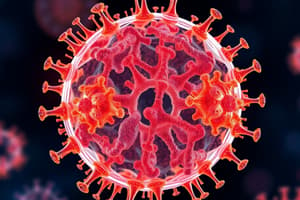Podcast
Questions and Answers
What is the role of enzymes in the body?
What is the role of enzymes in the body?
- They slow down reactions
- They decrease the rate of reactions
- They increase the rate of reactions without being changed in the overall process (correct)
- They change the reactants into useless pathways
How are enzymes assigned names?
How are enzymes assigned names?
- They are given three names: a short name, a systematic name, and a trivial name
- They are assigned two names: a short recommended name and a systematic name (correct)
- They are given only one name
- They are not assigned names
What is the suffix commonly used in enzyme names?
What is the suffix commonly used in enzyme names?
- -asein
- -zyme
- -ase (correct)
- -inase
Why are systematic names used?
Why are systematic names used?
How are enzymes classified in the systematic naming system?
How are enzymes classified in the systematic naming system?
What is a characteristic of some enzymes that retain their original trivial names?
What is a characteristic of some enzymes that retain their original trivial names?
What is the term for the active enzyme with its nonprotein component?
What is the term for the active enzyme with its nonprotein component?
What type of molecules can bind to enzymes and increase their activity?
What type of molecules can bind to enzymes and increase their activity?
What is the purpose of localizing enzymes in specific organelles within the cell?
What is the purpose of localizing enzymes in specific organelles within the cell?
What is the role of a catalyst in a chemical reaction?
What is the role of a catalyst in a chemical reaction?
What is the theory that explains the action of a catalyst?
What is the theory that explains the action of a catalyst?
What is the term for a coenzyme that only transiently associates with the enzyme?
What is the term for a coenzyme that only transiently associates with the enzyme?
What is the suffix attached to a description of the chemical reaction catalyzed by an enzyme?
What is the suffix attached to a description of the chemical reaction catalyzed by an enzyme?
What is the role of the active site in an enzyme molecule?
What is the role of the active site in an enzyme molecule?
What is the result of the binding of the substrate to the enzyme?
What is the result of the binding of the substrate to the enzyme?
How much faster do enzyme-catalyzed reactions proceed compared to uncatalyzed reactions?
How much faster do enzyme-catalyzed reactions proceed compared to uncatalyzed reactions?
What is the turnover number of an enzyme?
What is the turnover number of an enzyme?
What is a characteristic of enzymes in terms of their specificity?
What is a characteristic of enzymes in terms of their specificity?
What is the typical pH range at which most enzymes function?
What is the typical pH range at which most enzymes function?
What happens to the enzyme activity when the product concentration increases?
What happens to the enzyme activity when the product concentration increases?
What is the effect of ultraviolet radiation on certain enzymes?
What is the effect of ultraviolet radiation on certain enzymes?
What does a low Km value indicate about an enzyme's substrate affinity?
What does a low Km value indicate about an enzyme's substrate affinity?
At which pH does the enzyme pepsin function best?
At which pH does the enzyme pepsin function best?
What is the effect of extreme pH on enzyme activity?
What is the effect of extreme pH on enzyme activity?
What is the term for the energy required to convert a substance from its ground state to its transition state?
What is the term for the energy required to convert a substance from its ground state to its transition state?
How does the rate of an enzyme-catalyzed reaction change when the concentration of enzyme is increased?
How does the rate of an enzyme-catalyzed reaction change when the concentration of enzyme is increased?
What happens to the velocity of an enzyme reaction when the temperature is increased?
What happens to the velocity of an enzyme reaction when the temperature is increased?
What is the optimum temperature range for most enzymes?
What is the optimum temperature range for most enzymes?
Why do some enzymes, like Taq DNA polymerase, remain active at high temperatures?
Why do some enzymes, like Taq DNA polymerase, remain active at high temperatures?
What is the term for the increase in enzyme velocity when the temperature is increased by 10°C?
What is the term for the increase in enzyme velocity when the temperature is increased by 10°C?
Flashcards are hidden until you start studying



